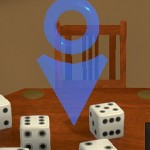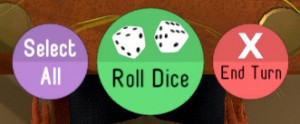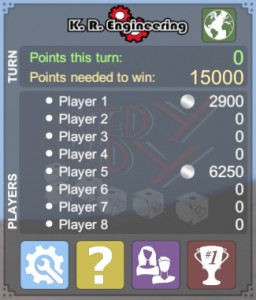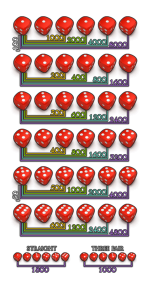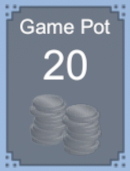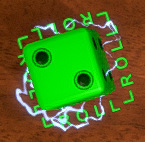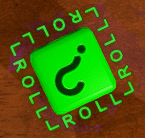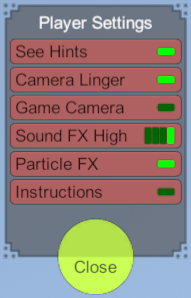Introduction
Greedy Greedy is a simple, but highly addictive fast-paced dice game for 2 to 8 players. The objective of the game is to get as many points as you can without getting too “greedy”. There is no limit to the number of rolls you can make in a turn, but if you fail to roll something of point value on each roll, then you lose everything you have accumulated for that turn.
Also Known As
Greedy Greedy goes by other names depending on where you learned it. You may know it as 10,000 (Ten-Thousand), Farkle, Stugots, or Zilch.
Useful Links
- Greedy Greedy on the PlayMore website.
- Greedy Greedy Sinespace tutorial video.
- Greedy Greedy on the Sinespace marketplace.
- Visit the Greedy Greedy region of Sinespace through your web browser.
House Rules
There are many ways to play Greedy Greedy, and often it is helpful to know what house rules you are playing when you sit down at a table. To that end, you can touch the Gear and Wrench icon on your game HUD to access the game settings. If you are not authorized to change the game settings, then these buttons will be grayed out, but will still show you what the current game settings are.
For a detailed explanation of what all of the settings buttons do, please see the Player Settings and Game Settings sections of this page.
Bug Fixes and Upgrades
If you are encountering what you believe to be a bug, please let us know so we can fix it! The easiest way to report an issue or request assistance is to use our contact form.
Your game will be automatically updated anytime a new version is available. If a new version has been made available and you don’t think your table has it yet, then you just need to either leave the region and come back, or log out and log back in. Nothing else should be required to update your game.
Due to the way Sinespace is designed, it is not possible to opt out of receiving updates. In most cases, if we’re adding or changing features, we will always include an option in the settings panel for these features so that you can choose not to use them, or revert to previous behavior. If an update includes a bug fix or corrects any other behavior in the game that was never intended to be there, then I’m sorry, but you will just have to accept the changes. If something in an update really bothers you, please let us know about it and we will see if there’s a solution we can work out for you.
Joining the Game
To join a game in Sinespace, all you need to do is sit down! Unoccupied seats in Sinespace have a large blue tag floating above them that looks like a circle with an arrow pointing down to the seat (see picture below). Click on this floating tag, and you will automatically be seated and become a player in the game. After being seated you should see buttons, score windows, and other game-related interface elements appear on your screen.
To leave the game at any time, simply stand up by clicking the “Stand Up” button at the bottom of your screen. All game-related buttons and windows should disappear.
Game Play
Game play begins with the first player to be seated. The seating arrangement is not important, since the game will skip any empty seats. If you stand up during the game, then you will be skipped. If it is your turn when you stand up, game play will automatically be passed to the next player.
Each player starts their turn by clicking the big green ROLL DICE button to make their first roll. You must then choose a die (or a combination of dice) that have score value to keep.
You can select and unselect dice simply by clicking on them. Selected dice will turn red and have the word KEEP around them. Unselected dice will be white or green and have the word ROLL around them, meaning they will be rolled again on your next roll of the dice. Blue dice are scored dice from previous rolls and cannot be changed or unselected.
Once you have selected some dice to keep, you can either keep rolling for more points by clicking the big green ROLL AGAIN button, or end your turn by clicking the big red END TURN button.
- At least one die of point value must be kept from each roll, but you don’t have to keep everything of point value.
- Blue dice cannot be used to create scoring combinations on later rolls.
- If you manage to use all six dice, you may re-roll all six again and continue accumulating points.
- You must select the dice you wish to keep and be scored even if you do not intend to roll again. The game makes no assumptions about what dice you might wish to keep when you end your turn.
- Players can hit the End Turn button before they roll to pass their turn if they wish.
The game is over when a player goes over 10,000 points. When that happens, everyone else gets one more round to beat them or die trying. You must roll until you win or bust.
Once a game has been won, a new game will be started automatically with the existing players. Players may choose to leave or join at any time.
Scoring
- Three of same dice counts as the number on the die multiplied by 100, except for 1s which are multiplied by 1000.
- 222 is 200 points.
- 333 is 300 points.
- 444 is 400 points.
- 555 is 500 points.
- 666 is 600 points.
- 111 is 1000 points.
- When you have more than three of the same dice, each additional die after the 3rd doubles the previous value. We will use 3s as our example here, but it applies equally to all numbers.
- 333 is 300 points (3 x 100).
- 3333 is 600 points ((3 x 100) x 2).
- 33333 is 1200 points (((3 x 100) x 2) x 2).
- 333333 is 2400 points ((((3 x 100) x 2) x 2) x 2).
- The only numbers that are worth anything by themselves are 1 and 5. Both of these numbers can also be used in combos as seen above.
- 1 is worth 100 points by itself. Two 1s together do not form any special combo and would be worth 100 + 100 points.
- 5 is worth 50 points by itself. Two 5s together do not form any special combo and would be worth 50 + 50 points.
- Three Pairs: 3 pairs (e.g. 225566) is worth 1000 points
- By default, four-of-a-kind plus two-of-a-kind (e.g. 222244) also counts as 3 pairs, unless “Full Houses” have been disabled in the game settings.
- Straights: A straight using all six dice as 123456 is worth 1800 points.
- By default, a short straight can be scored with 12345 or 23456 for 900 points, unless “Short Straights” have been disabled in the game settings.
Important: Scoring combinations only count if all of the dice needed to make the combination are rolled at the same time. If you roll 1, keep it, roll another 1, keep it, and roll a third 1…you now have three 1s, but since you didn’t roll them at the same time then this is only 300 points (100+100+100), not 1000 points.
Buy-Ins
Greedy Greedy supports playing with SILVER buy-ins. GOLD buy-ins are not supported!
When silver buy-ins are enabled, you will see a Game Pot panel above the scores. If you join a game with buy-ins enabled, you will not be allowed to play until you have paid in the necessary amount of silver. When a game is over, the winner takes the entire game pot of silver. Buy-ins can range from 10 silver up to 100 silver.
If you have already paid in, a green PAID stamp will appear on the game pot panel. If you have not paid in yet, a button labeled “PAY <amount required>” will appear letting you know how much you must pay to play on this table. If you’re not interested in paying to play, you can always play at a different table.
Variants
All of the variants below can be used individually, at the same time, or in any combination that you prefer.
These variants can be enabled or disabled by game owners from the Settings window. For more information on how to do that, see the Game Settings section below.
Zilch
Zilch is a variant of Greedy Greedy whereby you risk more when busting, but it is also made more difficult to bust. The new rules are:
- If you bust (score nothing) for three turns in a row, you lose all accumulated points for the entire game so far, not just points accumulated on that turn as with a normal bust. Your bust count is reset back to 0 the moment you have a normal scoring turn. The game will warn you if you have 2 busts and are in eminent danger of losing everything. Be sure not to bust a third time! It may be worth taking a low scoring roll in this case just to avoid busting. Your number of busts are shown as asterisks next to your score on the game HUD.
- If you have a set of three or more dice from a previous roll that form a valid combo (example: you have 444 as blue saved dice) and you roll an additional 4 on subsequent rolls, you may add the 4 to the previous set. This will not earn you any points, as the additional 4 would be worth 0 by itself, but it may save you from busting!
Amish Dice
Amish Dice is a variant of Greedy Greedy whereby you can choose to “take over” rolls from previous players’ turns. For example, if the player before you rolls 1,1,1,5,2,3, they are likely to keep the 1,1,1,5 and end their turn, thereby scoring 1050 points. Now that it is your turn, you have a choice to make:
- Press the ROLL button to take over their roll. The game will treat this as if you were the person who had rolled the original 111523 and had kept the 1115. This means if you choose to keep rolling, you are only rolling the remaining 2 and 3 that were not kept.
- If you bust on an Amish takeover, you are done, and play passes to the next player.
- If you do not bust, and succeed in rolling additional dice of point value, such as 1 and 4, then you have successfully taken over your opponent’s roll! You now get to keep both your opponent’s original roll of 1050 points, plus whatever you have added to it. You may continue to play as normal, keeping the 1 and rolling the 4 again if you wish, to try and add more points, or end your turn. After successfully taking over an opponent’s turn, play proceeds as normal.
- Press the ABANDON button to choose NOT to take over their roll. This will reset the dice. You may now click the ROLL button to begin a fresh roll of your own as you would on any other turn.
- There is no limit to the number of times an Amish roll may be passed around. One player may score 500 points and stop, the next may take over and add another 200 points to it, stopping with a total of 700. The player after that may choose to take it over as well, and another 400 points to it, thereby stopping with 1100, and so on. This can continue indefinitely until someone busts, and then it starts over again.
- You may not take over a roll that used all six dice to score. This presents players with the option of disallowing the next player from taking over their roll while still keeping their points. It also doesn’t make any sense for a player to be able to take over a roll where all six dice have been used, because there is zero added risk for taking the previous player’s roll.
Amish Dice is interesting because it alters the strategy of the game. In general, you will want to end your turn in such a way that it is as hard as possible for the next player to take over your score. Of course, this means leaving as few dice unrolled as possible, which is also very risky. Is it better to bust and leave your opponent nothing, than to keep your score and give them the possibility of taking over? That’s for you to decide!
Crazy Dice
When using Crazy Dice, all six dice are swapped out for a set of dice that special markings on one side each and will crackle with electric energy when showing. Each die is unique, in this case.
- One of the dice only has special markings on the 1 side.
- One of the dice only has special markings on the 2 side.
- One of the dice only has special markings on the 3 side.
- One of the dice only has special markings on the 4 side.
- One of the dice only has special markings on the 5 side.
- One of the dice only has special markings on the 6 side.
These special dice do not effect the way the game plays, but understanding how they work may prompt you to make different choices about which dice to keep on your roll. Anytime you are able to incorporate a specially marked die into your “kept” roll, then you gain a point bonus. If you can incorporate 2 such specially marked die into your roll, then you get an even bigger bonus! The same holds true for 3, 4, 5, and 6 specially marked die all used at once. The bonuses you receive for each crazy die are as follows:
- If you use 1 crazy die, your roll value is: Score x 2 (total bonus: x2.0)
- If you use 2 crazy die, your roll value is: Score x 2 x 1.5 (total bonus: x3.0)
- If you use 3 crazy die, your roll value is: Score x 2 x 1.5 x 1.25 (total bonus: x3.75)
- If you use 4 crazy die, your roll value is: Score x 2 x 1.5 x 1.25 x 1.125 (total bonus: ~x4.2)
- If you use 5 crazy die, your roll value is: Score x 2 x 1.5 x 1.25 x 1.125 x 1.0625 (total bonus: ~x4.48)
- If you use 6 crazy die, your roll value is: Score x 2 x 1.5 x 1.25 x 1.125 x 1.0625 x 1.03125 (total bonus: ~x4.62)
As you can see, the bonus you get from each additional crazy die is compounded, but diminishing. You only get half as much of a boost from the second die as you get from the first, and halving each time.
Here are some examples of crazy die in action:
- You choose to keep 333 from your roll. This is normally worth 300 points. If one of those 3s happens to be a crazy die, it becomes worth 600 points. It doubled!
- You choose to keep 224466 from your roll. This is normally worth 1000 points. If one of those dice happens to be crazy, it becomes worth 2000 points. If 2 of those dice happen to be crazy, it becomes worth 3000 points.
- You choose to keep 1115 from your roll. Ordinarily, you might decide not to keep the 5, because it is of very low point value and you could possibly do better by rolling it again. However, if the 5 is crazy in this situation, keeping what is on its own a very low value die will double the value of everything from 1050 to 2100.
- The only way to use all 6 crazy dice at once is a full straight of 123456. If you’re incredibly lucky and all 6 come up as crazy dice, then this roll normally worth 1800 becomes worth 8250. Here’s how:
- 1st crazy: 1800 * 2 == 3600
- 2nd crazy: 3600 * 1.5 == 5400
- 3rd crazy: 5400 * 1.25 == 6750
- 4th crazy: 6750 * 1.125 == 7550
- 5th crazy: 7550 * 1.0625 == 8000
- 6th crazy: 8000 * 1.03125 == 8250
If you’re an astute mathematician, you might notice that the numbers are a little bit off. This is because score values are always rounded down to the nearest 50.
Crazy Dice mean the game usually escalates more quickly and finishes faster than a game played with regular dice.
Wild Dice
Wild Dice is a bit of a misnomer, as there is actually only 1 wild die. If you get lucky and roll the wild die (as of this writing, represented by a ? on the wild face), you will be required to declare the value of the die before continuing. When a wild die is showing, a selection panel will appear above the ROLL button for you to choose from. Once you have declared the value of the wild die, it cannot be changed again for the current roll. If you roll a wild again later, even if it is on the same turn, then you can pick a different value for it. After declaring the value of the die, play continues as normal.
If playing with both Wild Dice and Crazy Dice enabled, the wild die is always Crazy 6. If you think of the dice as actual physical dice, the Wild Die replaces the 1 on the same die as Crazy 6. So if you get a Wild Die, and you want it to be Crazy, choose 6. Of course, if you choose 6 and there’s no way for you to use a 6 in your current roll, it won’t do you any good, so only choose 6 if you can use it.
Player Settings
In addition to game settings (discussed below), Greedy Greedy also supports individual player settings. These are settings that only affect your experience of the game. The settings here are not visible to anyone else, and changing them will change anyone else’s experience of the game, only yours.
These settings are remembered by our game server and will follow you around Sinespace. If you play a Greedy game in the Welcome Centre, for example, then go home and play Greedy on your own table, these two games will share the same settings that you have set.
To access the player settings, simply click on the purple button on the game HUD that shows a picture of two people. The following settings are available:
- See Hints: On by default. Turning this off means that you will no longer see game hints at the top of your screen when playing, even if hints are enabled in the game settings.
- Camera Linger: On by default. When on, the camera will continue to look at the last person who played for several seconds before changing to the next person. This allows you to see their animated reactions to the game.
- Game Camera: On by default. Turn this off if you do not want the game to automatically move your camera around while playing. When off, you can move your camera yourself using the normal mouse controls.
- Sound FX ____: Set to HIGH by default. This allows you to adjust the volume of the game sound effects, including turning them off completely if you wish.
- Particle FX: On by default. Turning this off will disable all particle effects on the game, such as fire, electricity, etc. This can help with performance on slow machines, but it’s not nearly as fun.
- Instructions: On by default. Turn this off to hide the instructions paper visible on the game table. The dice will also be moved to the center of the table when the instructions are off, rather than off to the side.
Game Settings
To access the game’s settings, simply click on the blue Gear and Wrench button on the game HUD. You can access the settings menu even if you are not the game owner, but only the game owner can change them.
- Crazy Dice: Toggle the Crazy Dice variant on or off. See the Crazy Dice section for details.
- Amish Rules: Toggle the Amish Rules variant on or off. See the Amish Dice section for details.
- Zilch Rules: Toggle the Zilch Rules variant on or off. See the Zilch section for details.
- Wild Dice: Toggle the Wild Dice variant on or off. See the Wild Dice section for details.
- Initial Barrier: Toggle the Initial Barrier setting on or off. Off by default, the initial barrier requires players to score a minimum of 1000 points before they can begin scoring. Once they have scored their first 1000 points, they may then stop with as few points as they like on subsequent rolls.
- Fullhouses: Toggle the Fullhouses setting on or off. On by default, this enables the “Full House” feature of Greedy. This allows you to count 4-of-a-kind plus 2-of-a-kind as a “full house”, which is equivalent to three pairs. See the Scoring section for more details.
- Short Straights: Toggle the Short Straights setting on or off. On by default, this allows 12345 or 23456 to be counted as a small or short straight, worth 900 points. See the Scoring section for more details.
- Playing to ___: Cycle through the end goal amounts needed to win the game. Options are 4000, 7000, 10000, and 15000 points to win.
- Buy-In ___: Cycle through the levels of buy-in the game requires in SILVER to play. OFF by default. See the Buy-Ins section for details.
- Timeout ___: Cycle through the turn timeout periods supported by the game. Options are 10 seconds, 20 seconds, 30 seconds, 60 seconds, 90 seconds, and 180 seconds. Players who are idle for longer than this period of time during their turn will be automatically skipped.
- Hinting: Toggle the Hinting setting on or off. When on, the game will provide hints to the player based on their rolls throughout the game. Good for new players learning to play, but too much of a crutch for experienced players.
- Autoplayers: Toggle individual Autoplayers on or off. Pressing this button will open a submenu where you can choose which of the seats on the game are occupied by NPC AI (computer) players. You can only have a maximum of 4 autoplayers active at the same time.
Additional Questions
Please be advised that the other articles on this website refer to the Second Life incarnation of Greedy Greedy. If you have a question about Sinespace Greedy Greedy, please contact us for assistance.
PlayMore Disclaimer
K.R. Engineering games in Sinespace make heavy use of an external web server operated by K.R. Engineering and not by Sine Wave Entertainment, Ltd. This external web server runs the game, and records high scores, player achievements, and other game aspects.
By playing a K.R. Engineering game in Sinespace, you accept that your account number, user name, and game activity will be recorded by our server. Your account number and user name are publicly available information that we are simply recording in order to match scores and achievements to the person who earned them. Your Sinespace user name and game activity (high scores and earned achievements) will be displayed on the PlayMore website.
ChangeLog
You can find the ChangeLog for the Sinespace version of Greedy Greedy by visiting this article.

